Disable Hibernate Mode Windows 10
- Disable Hibernate Mode Windows 10
- How To Exit Hibernate Mode
- Disable Hibernate Windows 10 Cmd
- Windows 10 Sleep Mode Disable Hibernate
Windows 10 Tip: How to Disable Hibernation with SSD Disks A Note on Hibernation versus Sleep Mode. Unlike hibernation, sleep works in a different way. Finding Disk Space Used by hiberfil.sys. Open the command prompt with administrative privileges. Saving SSD Disk Space and Life. If you’re looking.
The sleep mode or sleep state is a low-power state available in Windows operating system, including Windows 10. This low power sleep mode comes in handy, especially for notebook and tablet users to extend the battery life.
Disable Hibernate Mode Windows 10
Apr 26, 2016 Here at Puget Systems we have seen some issues with Sleep mode and Hibernation in Windows 10, so I wanted to write this article showing how to disable each of them if you’re having issues with either. Sleep mode is typically used when you want to step away from your computer for a bit and have the system enter a lower power state. Oct 17, 2017 For Windows 10, select Start, and then select Power Hibernate. You can also press the Windows logo key + X on your keyboard, and then select Shut down or sign out Hibernate. For Windows 8.1 / Windows RT 8.1, move your mouse to the lower left-hand corner of the screen and right-click the Start button or press Windows logo key + X on your. Feb 11, 2016 Discuss: How to enable or disable hibernate in Windows 10 Sign in to comment. Be respectful, keep it civil and stay on topic. We delete comments that violate our policy, which we encourage you to.
What’s sleep mode in Windows 10?
Unlike Hibernation, when a device is put into sleep mode or state, it will draw a very small amount power, but you will be able to resume your work very quickly (almost instantly) by pressing any key on the keyboard, moving the mouse/touchpad, or pressing the power button.
Since the sleep state draws a small amount of power, on a battery powered device, if the battery level falls below critical level, Windows automatically puts the device into the hibernation mode (if enabled) to prevent any data loss.
With default settings, your PC might go to the sleep mode after 15 (when on battery) or 30 (when pugged in) minutes of inactivity. This also means that, at times, your Windows 10 PC might go to sleep mode when a program is running in the background, resulting in loss of data.
For instance, your Windows 10 PC might go to the sleep mode when a file is being download via a web browser, forcing you to start the download all over again if the server from where you are downloading the file doesn’t offer resume support.
If you find that the sleep mode is not so useful, you can either configure your PC to enter the sleep mode after a long period of user inactivity or make your Windows 10 PC never sleep.
Follow the given below instructions to enable or disable sleep mode in Windows 10.
Method 1
Enable or disable sleep mode
Step 1: Open Settings app. To do so, click on the Settings app icon on the Start menu or simultaneously press Windows and I keys.
Step 2: Click the first option titled System.
Within minutes you'll be able to hack any fb account online that you wish to hack on. We don't take responsibility. Utilizing our free portalsite, it is possible to safely hack on fb accounts, group or page. We don't charge to our hacking also our FB hacker along with any password is the online facebook hack. Easy hack fb account free.
Step 3: On the resulting page, click Power & Sleep.
Step 4: Now, under Sleep section, you will see two options:
#On battery power, PC goes to sleep after
How To Exit Hibernate Mode
#When plugged in, PC goes to sleep after

For both options, expand the drop-down menu and select Never. That’s it! Your PC will never go to sleep mode again. Here, as you can see in the above picture, you can configure how long should Windows 10 wait before putting the computer to sleep mode.
Note that changes made to the sleep mode will apply to the current power plan only. To make changes to other power plans, switch to the other power plan by clicking the battery icon in the system tray and then click on the current power plan tile (as shown in the following image) to switch between all available power plans.
Once a different power plan is selected, repeat above mentioned steps to configure or disable sleep mode for that plan.
Method 2
Another way to make your Windows 10 PC never sleep
Disable Hibernate Windows 10 Cmd
Step 1: Type Power Options in the Start menu or taskbar search box and then press Enter to open the classic Power Options window.
Step 2: On the left-pane, click Change when the computer sleeps link to open Edit plan settings window.
Step 3: Here, in the drop-down menus next to Put the computer to sleep, select Never for On battery and Plugged in. Click Save changes button. That’s it!
Windows 10 Sleep Mode Disable Hibernate
Note that, instead of selecting Never, selecting any other number will enable the sleep mode in Windows 10.
IMPORTANT: You need to repeat the above mentioned steps for all power plans. That is, if you have disabled sleep mode for Power Saver plan, you will need to do the same for Balanced and other plans (if you have created) to avoid Windows 10 putting your PC into the sleep mode while on these power plans.
